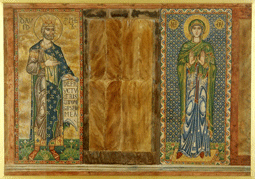Study of Mosaic: 'King David and the Madonna'
South Aisle, San Marco, Venice. Thomas Matthews Rooke (1842-1842). Watercolour and gold on paper, 1879.
WorkIn this study, Rooke has recorded two figures from the south wall of the Basilica: King David and the Madonna. Ruskin described these figures as the 'grand upright.'Ruskin commissioned studies of these flat mosaics after Rooke had spent a long period copying the curved mosaics from the domes of San Marco. He painted the dome mosaics in a way that made them appear flat, because Ruskin had asked for the 'facts point blank of each figure' (Works, 30, p. lvii) rather than perspective copies. Copying the flat walls might therefore have been a relief to Rooke. Ruskin was particularly interested in the shiny surface of these flat mosaics and wrote to Rooke: 'these present no difficulty of curved surface and may be drawn as large as you like, but ought to be in very deep tone, representing their shaded position with the sparkles of jewelled colour and gold flecking.' (Works, 30, p. lvii).
Artist Rooke first worked in an army agent's office before attending evening classes in art and became a student at the Royal Academy in 1868. The following year he was employed by the designer William Morris's firm and became an assistant and close friend of the artist Edward Burne-Jones.Rooke enjoyed success as an artist in his own right. He painted large biblical scenes in a style influenced by Burne-Jones and Renaissance art, and exhibited at the Royal Academy. When Ruskin employed him, Rooke worked in a different style, drawing in watercolours and painting from life. Later, Rooke painted records of architecture for the Society for the Preservation of Pictorial Records of Ancient Works of Art. Ruskin on MosaicRuskin considered ancient mosaic of the kind at San Marco 'the most important branch of early Christian art. Collection of the Guild of St George, Museums Sheffield
' He saw the mosaics as an illustrated Bible, which 'could not be ignored or escaped from' (Works, 10, p. 132) by the worshipper. The style of these mosaics is described as 'Byzantine', a style that originated in Greece and Turkey during the late Roman times and culminated in the 1100s. Ruskin saw Byzantine art as an important stepping-stone from ancient classical art. Rejecting the conventional descriptions of the style as 'barbarous' or primitive, he presented it as a pioneering style, an influence on later art.In the course of his correspondence with Rooke, Ruskin wrote that 'The real fact is that all Byzantine mosaic (and all Eastern colour) has splendour for its first object -- and its type is the peacock's tail.'.He adds, for Rooke's benefit, that 'If your drawings glow and melt like that you are right': 'Peacock's tail in shade or light it may be -- and much sober brown in any light may mix with its violet and gold -- but that is what the mosaicist wanted to do, and for the most part did'.Ruskin concludes, provocatively, that 'All that is grey, cold, reserved, or modest, in these mosaics (in any other sense than a humming-bird or flamingo or pheasant -- or aforesaid peacock -- is modest) is European, mostly Roman, some of it German -- all of it bad.' (Works, 30, p. lviii).
|



















